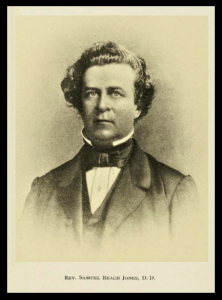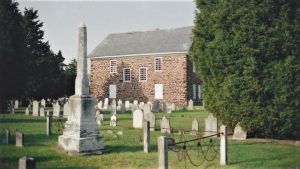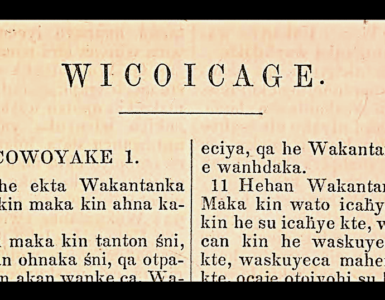 Samuel Beach was born November 23, 1811 in Charleston, South Carolina to Paul Townsend and Mary Lamball (Beach) Jones. His paternal grandfather owned a rice plantation and his mother’s ancestors maintained a large estate in Charleston as well as plantations on James Island. Samuel’s brother was named Paul Townsend for their father and their sister Eliza would grow up to marry Rev. Henry A. Boardman, D. D. The children received their early schooling in Charleston until their mother took them to New Jersey for further education with Samuel attending the Academy at Morristown. During his Yale College years Samuel professed faith in Christ at the age of nineteen in the College Church. After graduation, Samuel returned to New Jersey to attend Princeton Seminary where he received the certificate for completion of studies in 1836 after four years which included not only the required curriculum but additional subjects of personal interest.
Samuel Beach was born November 23, 1811 in Charleston, South Carolina to Paul Townsend and Mary Lamball (Beach) Jones. His paternal grandfather owned a rice plantation and his mother’s ancestors maintained a large estate in Charleston as well as plantations on James Island. Samuel’s brother was named Paul Townsend for their father and their sister Eliza would grow up to marry Rev. Henry A. Boardman, D. D. The children received their early schooling in Charleston until their mother took them to New Jersey for further education with Samuel attending the Academy at Morristown. During his Yale College years Samuel professed faith in Christ at the age of nineteen in the College Church. After graduation, Samuel returned to New Jersey to attend Princeton Seminary where he received the certificate for completion of studies in 1836 after four years which included not only the required curriculum but additional subjects of personal interest.
Jones was licensed by the Presbytery of New Brunswick during its sessions at Princeton, February 3, 1835, and was ordained October 4, 1837. The ordination service included a sermon delivered by pastor of the Princeton Church, Benjamin H. Rice; David Comfort presided and proposed the constitutional questions; and Princeton Seminary Professor Archibald Alexander gave the charge to Jones. He was immediately sent as an evangelist to Mississippi to become Professor of Theology and Hebrew in Oakland College. Oakland College was founded by Presbyterians in 1830. One headline making event in the history of Oakland would be the murder of its president Jeremiah Chamberlain in 1851 when he was stabbed to death for his strong Unionist views by local planter George Briscoe. Oakland enjoyed some prominence among schools in the South until the Civil War left it one of many devastated institutions.
Whether it was the challenge of teaching college, cultural assimilation, the Mississippi climate, or the needs of his June 1838 bride Sarah Ralston Chester, Jones did not stay at Oakland for long. By October 1838 he was supplying First Presbyterian Church in Bridgeton, New Jersey. The congregation quickly took to his ministry because the Presbytery of Philadelphia installed him pastor May 9, 1839. For the installation service Rev. Joseph H. Jones preached on Acts 11: 24, “For he was a good man and full of the Holy Ghost.” Samuel’s brother-in-law (or future brother-in-law), Rev. Henry A. Boardman, proposed the constitutional questions and delivered the pastoral charge, and Rev. George W. Janvier charged the congregation. During his tenure the church enjoyed a steady and prosperous growth with 411 members added by profession of faith and transfer. But with the beginning of the Civil War sectional issues led to tension within the congregation.
Even though Jones spent nearly twenty-four years serving the Bridgeton flock as a minister of the Presbyterian Church in the United States of America (PCUSA) Old School, he was not always in sympathy with the deliverances of his judicatories particularly when they addressed what he believed were strictly political issues. The Civil War began in the spring of 1861 and the Old School General Assembly adopted the Gardiner Spring Resolutions which in essence called for all churches to support the Union and its policies. This resulted in many Presbyterians in the South leaving to form their own church. For Jones, the Resolutions imposed political opinions upon the church, nevertheless he continued at Bridgeton despite the increasing tension within his flock and among the elders. The situation deteriorated such that the session confronted Jones about the disharmony and their belief that his views were impeding his ministry. Jones took the constitutionally irregular step of simply resigning without bringing the issue before the congregation to have a formal vote. It was with some difficulty that the Presbytery of West Jersey (first enrolled commissioners to General Assembly, 1844) worked through the situation and dissolved his call on May 21, 1863. It was a bitter but necessary pill for Jones to swallow because he had been an integral and respected part of his presbytery, however matters would get worse.
When a minister’s relationship with a church is dissolved it is generally for the purpose of releasing him for a call to another church which may or may not be within the same presbytery. Jones had no church to go to, so he remained in the Presbytery of West Jersey without a call but continued preaching. What would his next step be? After a few years supplying pulpits in the spring of 1866 he requested dismissal from West Jersey to the Presbytery of East Hanover in the Presbyterian Church in the United States (PCUS). The PCUS was made up primarily of churches in the South that had left the PCUSA Old School because of unwillingness to comply with the Gardiner Spring Resolutions. His request for transfer led to considerable debate at the Presbytery of West Jersey meeting resulting in postponement of any action. West Jersey was concerned that Jones as a PCUS minister working within its geographic bounds would influence churches to leave its jurisdiction. During recesses of the Synod of New Jersey in October the Presbytery of West Jersey was able to convene and instruct its stated clerk to send Jones a letter formally asking for his reasons for transferring to East Hanover Presbytery with the directive that he responds in time for the presbytery meeting in November. Jones was not happy. He argued that West Jersey had no right to make his dismissal contingent on his plans and it was an insult to him as a presbyter in good standing. He informed West Jersey that he would not pursue a transfer but instead would use the stated clerk’s inquiry letter as proof of good standing for transfer to East Hanover Presbytery. There were constitutional irregularities in this whole process, but in the end, it was a case of a presbytery with a minister whose views were considered objectionable being given up to a presbytery that did not. Things have not always been done decently and in order and following the Civil War individuals from both sections were sufficiently angry to have their vision for proper procedures blurred.
Jones was not the only dissatisfied minister in the Old School, there were others particularly in Missouri, Kentucky, and Maryland—especially Baltimore. West Jersey Presbytery’s concerns regarding what Jones might do if he worked while residing within its geographic bounds as a PCUS minister were proven true. In November 1866 a group representing Baltimore area churches gathered in the Franklin Street Church to establish a new presbytery. Jones, who was described as “a noble and manly Jerseyman,” gave the invocation before being elected moderator. Other ministers present were J. J. Bullock, J. B. Ross, and J. A. Lefevre, and representing the churches were ruling elders J. Harman Brown from Franklin Street, William Hogg of Franklin Square, and A. C. Gibbes from West River. The speeches and comments affirmed the men’s dissatisfaction with what they believed were non-constitutional actions by the Old School Assembly and its “incipient revolution that had altered the very nature of the Church.” The gathering established the independent Presbytery of Patapsco which was named for a river running through Maryland. The first stated meeting was held in April 1867 and Moderator Jones delivered a sermon from John 18:36 titled, “Christ’s Kingdom not of this World.” The next step was to connect Patapsco with the PCUS during the General Assembly held in Nashville, November 1867. The new judicatory was welcomed and its commissioners were seated on motion of Joseph R. Wilson as the Presbytery of Patapsco of the Synod of Virginia. Its geographic bounds were not stated, however, it did not include Bridgeton, New Jersey, because Jones continued for the remainder of his ministry laboring out of bounds of presbytery in the PCUS. How his intended transfer to East Hanover Presbytery played into all this was not determined. It is an admittedly confusing and troubling narrative of judicatory membership for Jones, but other ministers such as Stuart Robinson also experienced challenges with their presbyteries following the Civil War.
 Samuel Beach Jones lived out his days with a five-year tenure laboring out of bounds supplying the pulpit of the Old Stone Church in Fairfield, New Jersey. His ability to preach and minister ended when he was debilitated by a stroke the Lord’s Day morning of October 4, 1874. He survived handicapped for nearly ten years passing away March 19, 1883. During his ministry he was honored with the Doctor of Divinity from the College of New Jersey in 1851 and was one of its trustees from 1861 to 1866. He was a director of Princeton Theological Seminary from 1847 to 1864. He was chosen unanimously to be Moderator of the Synod of New Jersey at Princeton, October 21, 1851, and opened the Synod of New Brunswick in 1852 with a sermon from 2 Thessalonians 2:13, 14. Three times he was commissioned to the Old School General Assembly in 1846, 1852 and 1855. The funeral services were attended by many sorrowful friends. Of his family three children died in infancy. His wife and five children survived him. The widow died at Orange, New Jersey, March 20, 1891. A large portion of Doctor Jones valuable library of three thousand volumes was given to Columbia Theological Seminary which illustrates his sympathies were in the state of his birth despite a long residence in New Jersey and his attachments to Princeton Seminary.
Samuel Beach Jones lived out his days with a five-year tenure laboring out of bounds supplying the pulpit of the Old Stone Church in Fairfield, New Jersey. His ability to preach and minister ended when he was debilitated by a stroke the Lord’s Day morning of October 4, 1874. He survived handicapped for nearly ten years passing away March 19, 1883. During his ministry he was honored with the Doctor of Divinity from the College of New Jersey in 1851 and was one of its trustees from 1861 to 1866. He was a director of Princeton Theological Seminary from 1847 to 1864. He was chosen unanimously to be Moderator of the Synod of New Jersey at Princeton, October 21, 1851, and opened the Synod of New Brunswick in 1852 with a sermon from 2 Thessalonians 2:13, 14. Three times he was commissioned to the Old School General Assembly in 1846, 1852 and 1855. The funeral services were attended by many sorrowful friends. Of his family three children died in infancy. His wife and five children survived him. The widow died at Orange, New Jersey, March 20, 1891. A large portion of Doctor Jones valuable library of three thousand volumes was given to Columbia Theological Seminary which illustrates his sympathies were in the state of his birth despite a long residence in New Jersey and his attachments to Princeton Seminary.
Please visit the Presbyterians of the Past homepage and see the topical selections included in the recently updated “Notes & News” collection. Older entries no longer available on the homepage can be accessed in the “Notes & News Archive.”
Barry Waugh
Notes—The header map is from the Library of Congress digital collection and it is dated 1819. The portrait of Jones is from, 1700-1900 Ancestry and Posterity of Johnson Reeves, Born October 16, 1799, Died July 19, 1860, and a Memorial Sermon by Rev. Samuel Beach Jones, D.D., Philadelphia: Allen, Lane & Scott, [1900]. The “Rev. Sam’l. Beach Jones, D. D., and His Times,” by Rev. Allen H. Brown, as in History of the Laying of the Corner Stone of The Presbyterian Church, Bridgeton, N. J., 100th Anniversary 26th, 1892, Bridgeton: Reeve & Fithian, 1892, pages 41-50. Bicentennial Celebration of the Old Stone Church, September 29, 1880, Published by the Request of Many, Bridgeton: A. M. Heston Printer, 1881, pages 96-97. Also, his memorial entry in the Princeton Theological Seminary Necrological Reports. Information about and quotes in the text concerning the Presbytery of Patapsco are from, Harold M. Parker, Jr., “Much Wealth and Intelligence: The Presbytery of Patapsco,” in Maryland Historical Magazine: A Quarterly 60 (June 1965), 160-74; one source said initially the new presbytery was named Presbytery of Chesapeake. The picture of the Old Stone Church of Fairfield, New Jersey was taken by the author in 2005. The obelisk monument in the foreground is for Rev. Ethan Osborne (1758-1858, who died just short of his 100th birthday). The church still exists as the Fairfield Presbyterian Church and it is a member of the Presbyterian Church in America (PCA) but the congregation meets at a different location.





